Siemens IPC427C User Manual

SIMATIC
Industrial PC
SIMATIC IPC427C
Operating Instructions
04/2009
|
Introduction |
1 |
|
|
|
|
Safety Instructions |
2 |
|
|
|
|
Description |
3 |
|
|
|
|
Application planning |
4 |
|
|
|
|
Installing/mounting |
5 |
|
|
|
|
Connecting |
6 |
|
|
|
|
Commissioning |
7 |
|
Integration into an |
|
|
8 |
|
|
Automation System |
|
|
|
|
|
Functions |
9 |
|
Expansions and |
|
|
10 |
|
|
Configurations |
|
|
|
|
|
Maintenance and Service |
11 |
|
Alarm, error and system |
|
|
12 |
|
|
messages |
|
|
|
|
|
Troubleshooting/FAQs |
13 |
|
|
|
|
_Technical specifications |
14 |
|
|
|
|
||
|
Dimension drawings |
15 |
|
|
|
|
Detailed descriptions |
16 |
|
|
|
|
Appendix |
A |
|
|
|
|
ESD guidelines |
B |
|
|
|
|
List of abbreviations |
C |
|
|
|
A5E02414743-01

Legal information
Warning notice system
This manual contains notices you have to observe in order to ensure your personal safety, as well as to prevent damage to property. The notices referring to your personal safety are highlighted in the manual by a safety alert symbol, notices referring only to property damage have no safety alert symbol. These notices shown below are graded according to the degree of danger.
 DANGER
DANGER
indicates that death or severe personal injury will result if proper precautions are not taken.
 WARNING
WARNING
indicates that death or severe personal injury may result if proper precautions are not taken.
 CAUTION
CAUTION
with a safety alert symbol, indicates that minor personal injury can result if proper precautions are not taken.
CAUTION
without a safety alert symbol, indicates that property damage can result if proper precautions are not taken.
NOTICE
indicates that an unintended result or situation can occur if the corresponding information is not taken into account.
If more than one degree of danger is present, the warning notice representing the highest degree of danger will be used. A notice warning of injury to persons with a safety alert symbol may also include a warning relating to property damage.
Qualified Personnel
The device/system may only be set up and used in conjunction with this documentation. Commissioning and operation of a device/system may only be performed by qualified personnel. Within the context of the safety notes in this documentation qualified persons are defined as persons who are authorized to commission, ground and label devices, systems and circuits in accordance with established safety practices and standards.
Proper use of Siemens products
Note the following:
 WARNING
WARNING
Siemens products may only be used for the applications described in the catalog and in the relevant technical documentation. If products and components from other manufacturers are used, these must be recommended or approved by Siemens. Proper transport, storage, installation, assembly, commissioning, operation and maintenance are required to ensure that the products operate safely and without any problems. The permissible ambient conditions must be adhered to. The information in the relevant documentation must be observed.
Trademarks
All names identified by ® are registered trademarks of the Siemens AG. The remaining trademarks in this publication may be trademarks whose use by third parties for their own purposes could violate the rights of the owner.
Disclaimer of Liability
We have reviewed the contents of this publication to ensure consistency with the hardware and software described. Since variance cannot be precluded entirely, we cannot guarantee full consistency. However, the information in this publication is reviewed regularly and any necessary corrections are included in subsequent editions.
Siemens AG |
A5E02414743-01 |
Copyright © Siemens AG 2009. |
Industry Sector |
04/2009 |
Technical data subject to change |
Postfach 48 48 90026 NÜRNBERG GERMANY
Table of contents
1 |
Introduction................................................................................................................................................ |
7 |
|
|
1.1 |
Preface........................................................................................................................................... |
7 |
|
1.2 |
Guideline to the Operating Instructions ......................................................................................... |
8 |
2 |
Safety Instructions..................................................................................................................................... |
9 |
|
|
2.1 |
General safety instructions ............................................................................................................ |
9 |
3 |
Description............................................................................................................................................... |
11 |
|
|
3.1 |
Overview...................................................................................................................................... |
11 |
|
3.2 |
Applications.................................................................................................................................. |
12 |
|
3.3 |
Features....................................................................................................................................... |
13 |
|
3.4 |
Windows Embedded Standard 2009........................................................................................... |
15 |
|
3.5 |
Design.......................................................................................................................................... |
17 |
|
3.5.1 |
External Design............................................................................................................................ |
17 |
|
3.5.2 |
Connection components.............................................................................................................. |
18 |
|
3.5.3 |
Operator controls......................................................................................................................... |
19 |
|
3.5.4 |
Status displays............................................................................................................................. |
20 |
4 |
Application planning................................................................................................................................. |
21 |
|
|
4.1 |
Transport...................................................................................................................................... |
21 |
|
4.2 |
Unpacking and checking the delivery unit ................................................................................... |
22 |
|
4.3 |
Ambient and Environmental Conditions....................................................................................... |
24 |
5 |
Installing/mounting................................................................................................................................... |
25 |
|
|
5.1 |
Permitted mounting positions....................................................................................................... |
25 |
|
5.2 |
Mounting information ................................................................................................................... |
27 |
|
5.3 |
Mounting the device..................................................................................................................... |
27 |
|
5.4 |
Mounting on DIN rails .................................................................................................................. |
28 |
|
5.5 |
Mounting with mounting brackets................................................................................................ |
30 |
|
5.6 |
Upright mounting.......................................................................................................................... |
32 |
6 |
Connecting .............................................................................................................................................. |
33 |
|
|
6.1 |
Connecting peripheral equipment................................................................................................ |
33 |
|
6.2 |
Connecting the 24 V DC power supply........................................................................................ |
34 |
|
6.3 |
Protective ground connection ...................................................................................................... |
35 |
|
6.4 |
USB strain-relief........................................................................................................................... |
36 |
SIMATIC IPC427C |
3 |
Operating Instructions, 04/2009, A5E02414743-01 |

Table of contents
7 |
Commissioning........................................................................................................................................ |
37 |
|
|
7.1 |
Note before commissioning......................................................................................................... |
37 |
|
7.2 |
Commissioning - Windows Embedded Standard 2009 .............................................................. |
38 |
|
7.2.1 |
Basic commissioning - initial startup........................................................................................... |
38 |
|
7.3 |
Commissioning - Windows XP Professional............................................................................... |
40 |
|
7.3.1 |
Basic commissioning - initial startup........................................................................................... |
40 |
|
7.3.2 |
Setting up the language selection for Windows XP Professional / Embedded Standard........... |
41 |
|
7.4 |
Commissioning - other operating systems.................................................................................. |
42 |
|
7.4.1 |
Commissioning - guide................................................................................................................ |
42 |
8 |
Integration into an Automation System.................................................................................................... |
43 |
|
|
8.1 |
Overview..................................................................................................................................... |
43 |
9 |
Functions................................................................................................................................................. |
45 |
|
|
9.1 |
Monitoring Functions................................................................................................................... |
45 |
|
9.1.1 |
Introduction ................................................................................................................................. |
45 |
|
9.1.2 |
Temperature monitoring/display ................................................................................................. |
46 |
|
9.1.3 |
Watchdog (WD)........................................................................................................................... |
47 |
|
9.2 |
Enhanced Write Filter (EWF)...................................................................................................... |
48 |
|
9.3 |
File Based Write Filter (FBWF)................................................................................................... |
50 |
|
9.4 |
SRAM buffer memory.................................................................................................................. |
52 |
|
9.5 |
Battery monitoring....................................................................................................................... |
53 |
|
9.6 |
Operation without monitor and keyboard.................................................................................... |
54 |
10 |
Expansions and Configurations............................................................................................................... |
55 |
|
|
10.1 |
Open the device (front panel) ..................................................................................................... |
55 |
|
10.2 |
Memory expansion...................................................................................................................... |
57 |
|
10.2.1 |
Installing the memory module..................................................................................................... |
57 |
|
10.3 |
Installing PCI-104 / PC/104 Plus modules.................................................................................. |
59 |
|
10.3.1 |
Notes on the modules................................................................................................................. |
59 |
|
10.3.2 |
Mounting PCI-104 or PC/104 Plus modules............................................................................... |
60 |
|
10.4 |
Installing/Removing Compact Flash Cards................................................................................. |
62 |
|
10.4.1 |
Installation options for Compact Flash cards.............................................................................. |
62 |
|
10.4.2 |
Installing/removing an accessible Compact Flash card.............................................................. |
63 |
|
10.4.3 |
Installing/removing a built-in Compact Flash card...................................................................... |
66 |
11 |
Maintenance and Service ........................................................................................................................ |
67 |
|
|
11.1 |
Removing and Installing Hardware Components........................................................................ |
67 |
|
11.1.1 |
Repairs........................................................................................................................................ |
67 |
|
11.1.2 |
Preventive maintenance.............................................................................................................. |
68 |
|
11.1.3 |
Replacing hard disk or SSD drive............................................................................................... |
69 |
|
11.1.4 |
Replace the backup battery........................................................................................................ |
71 |
|
11.2 |
Reinstalling the operating system............................................................................................... |
73 |
|
11.2.1 |
Windows Embedded Standard 2009 .......................................................................................... |
73 |
|
11.2.1.1 |
General installation procedure.................................................................................................... |
73 |
|
11.2.1.2 |
Restoring the software to factory state using the Restore DVD ................................................. |
74 |
|
11.2.2 |
Windows XP Professional........................................................................................................... |
76 |
|
11.2.2.1 |
General installation procedure.................................................................................................... |
76 |
4 |
|
SIMATIC IPC427C |
|
|
Operating Instructions, 04/2009, A5E02414743-01 |
||
|
|
|
Table of contents |
|
11.2.2.2 |
Restoring the Software to Factory State Using the Restore DVD............................................... |
77 |
|
11.2.2.3 |
Setting up the operating system via the Recovery CD/DVD ....................................................... |
79 |
|
11.3 |
Partitioning data media................................................................................................................ |
81 |
|
11.3.1 |
Setting up the partitions under Windows Embedded Standard 2009.......................................... |
81 |
|
11.3.2 |
Setting up the partitions under Windows XP Professional .......................................................... |
82 |
|
11.4 |
Installing drivers and software ..................................................................................................... |
83 |
|
11.4.1 |
Driver installation under Windows Embedded Standard 2009.................................................... |
83 |
|
11.4.2 |
Installing drivers and software ..................................................................................................... |
83 |
|
11.5 |
Installing updates......................................................................................................................... |
84 |
|
11.5.1 |
Updating the operating system.................................................................................................... |
84 |
|
11.5.2 |
Installing or updating application programs and drivers.............................................................. |
84 |
|
11.5.3 |
Performing a BIOS update........................................................................................................... |
85 |
|
11.6 |
Data backup................................................................................................................................. |
86 |
|
11.6.1 |
Creating an image........................................................................................................................ |
86 |
12 |
Alarm, error and system messages......................................................................................................... |
87 |
|
|
12.1 |
Boot error messages.................................................................................................................... |
87 |
13 |
Troubleshooting/FAQs............................................................................................................................. |
89 |
|
|
13.1 |
General problems ........................................................................................................................ |
89 |
|
13.2 |
Problems when using modules of third-party manufacturers ...................................................... |
90 |
14 |
Technical specifications........................................................................................................................... |
91 |
|
|
14.1 |
General specifications.................................................................................................................. |
91 |
|
14.2 |
Power requirements of the components...................................................................................... |
95 |
|
14.3 |
Integrated DC power supply ........................................................................................................ |
96 |
15 |
Dimension drawings ................................................................................................................................ |
97 |
|
|
15.1 |
Overview of the dimensional drawings........................................................................................ |
97 |
|
15.2 |
Dimension drawings of the device............................................................................................... |
98 |
|
15.3 |
Dimension drawings of the device with mounting brackets......................................................... |
99 |
|
15.4 |
Dimensional drawings of the device with vertical mounting angles........................................... |
101 |
|
15.5 |
Dimensional drawings of the device with expansion frames..................................................... |
102 |
|
15.6 |
Dimension drawing of the blanking plate................................................................................... |
103 |
16 |
Detailed descriptions ............................................................................................................................. |
105 |
|
|
16.1 |
Internal components .................................................................................................................. |
105 |
|
16.1.1 |
Overview of internal components............................................................................................... |
105 |
|
16.1.2 |
Technical features of the motherboard...................................................................................... |
106 |
|
16.1.3 |
External ports............................................................................................................................. |
107 |
|
16.1.3.1 |
Overview.................................................................................................................................... |
107 |
|
16.1.3.2 |
COM1/2...................................................................................................................................... |
107 |
|
16.1.3.3 |
DVI-I........................................................................................................................................... |
108 |
|
16.1.3.4 |
Ethernet...................................................................................................................................... |
109 |
|
16.1.3.5 |
USB............................................................................................................................................ |
109 |
|
16.1.3.6 |
PROFIBUS................................................................................................................................. |
110 |
|
16.1.3.7 |
CAN bus..................................................................................................................................... |
110 |
|
16.1.4 |
Internal ports.............................................................................................................................. |
111 |
|
16.1.4.1 |
Overview.................................................................................................................................... |
111 |
SIMATIC IPC427C |
|
5 |
|
Operating Instructions, 04/2009, A5E02414743-01 |
|||

Table of contents
|
16.1.4.2 |
Compact Flash card interface ................................................................................................... |
111 |
|
16.1.4.3 PCI-104 or PC/104-Plus interface (PCI part)............................................................................ |
112 |
|
|
16.2 |
BIOS Setup ............................................................................................................................... |
113 |
|
16.2.1 |
Overview ................................................................................................................................... |
113 |
|
16.2.2 |
Starting BIOS Setup .................................................................................................................. |
114 |
|
16.2.3 |
BIOS Setup menus ................................................................................................................... |
115 |
|
16.2.4 |
Main menu ................................................................................................................................. |
117 |
|
16.2.5 |
Advanced Menu ........................................................................................................................ |
122 |
|
16.2.6 |
Security menu ........................................................................................................................... |
125 |
|
16.2.7 |
Boot menu ................................................................................................................................. |
126 |
|
16.2.8 |
Version menu ............................................................................................................................ |
130 |
|
16.2.9 |
Exit Menu .................................................................................................................................. |
131 |
|
16.2.10 |
Default BIOS Setup entries ....................................................................................................... |
132 |
|
16.3 |
System resources ..................................................................................................................... |
135 |
|
16.3.1 |
Currently allocated system resources ....................................................................................... |
135 |
|
16.3.2 |
System resources used by the BIOS/DOS ............................................................................... |
136 |
|
16.3.2.1 |
PCI Interrupt Lines .................................................................................................................... |
136 |
|
16.4 |
I/O Address Areas ..................................................................................................................... |
137 |
|
16.4.1 |
Overview of the internal module registers ................................................................................. |
137 |
|
16.4.2 |
Watchdog enable register / 066h select register (read/write, address 062h) ........................... |
138 |
|
16.4.3 |
Watchdog trigger register (read only, address 066h) ............................................................... |
138 |
|
16.4.4 |
CAN base address register (write only, address 066h) ............................................................ |
139 |
|
16.4.5 |
Output register LED 1 / 2 (read/write, address 404Eh) ............................................................. |
140 |
|
16.4.6 |
Battery status tab (read - only, address 50Fh) ............................................................................ |
141 |
|
16.4.7 |
SRAM address register ............................................................................................................. |
142 |
A |
Appendix |
................................................................................................................................................ |
143 |
|
A.1 |
Guidelines and declarations ...................................................................................................... |
143 |
|
A.2 ......................................................................................................... |
Certificates and approvals |
144 |
|
A.3 .................................................................................................................. |
Service and support |
146 |
B |
ESD guidelines...................................................................................................................................... |
147 |
|
|
B.1 ......................................................................................................................... |
ESD Guidelines |
147 |
C |
List of abbreviations............................................................................................................................... |
149 |
|
|
C.1 ............................................................................................................................ |
Abbreviations |
149 |
|
Glossary ................................................................................................................................................ |
|
155 |
|
Index...................................................................................................................................................... |
|
167 |
6 |
SIMATIC IPC427C |
Operating Instructions, 04/2009, A5E02414743-01 |
Introduction |
1 |
1.1Preface
Objective of this documentation
These operating instructions contain all the information you need for commissioning and operation of the SIMATIC IPC427C.
It is intended both for programming and testing personnel who commission the device and connect it with other units (automation systems, programming devices), as well as for service and maintenance personnel who install add-ons or carry out fault/error analyses.
Basic knowledge requirements
A solid background in personal computers and Microsoft operating systems is required to understand this manual. General knowledge in the field automation control engineering is recommended.
Scope of validity of this document
The operating instructions are valid for all supplied variations of the SIMATIC IPC427C and describe the delivery status as of May 2009.
Position in the information landscape
The documentation for the SIMATIC IPC427C includes the following sections:
●SIMATIC IPC427C, Operating Instructions (Compact)
●SIMATIC IPC427C, Operating Instructions
The documentation is supplied in German and English with the device in electronic form as a PDF file on the "Documentation and Drivers" DVD.
Conventions
The term "PC" or "device" is sometimes used to refer to the SIMATIC IPC427C product in this documentation.
History
Currently released versions of this operating manual:
|
Edition |
Comment |
|
04/2009 |
First edition |
SIMATIC IPC427C |
7 |
|
Operating Instructions, 04/2009, A5E02414743-01 |
||

Introduction
1.2 Guideline to the Operating Instructions
1.2Guideline to the Operating Instructions
Contents format |
Table of Contents |
Contents |
Organization of the documentation, including the index of pages and chapters |
Introduction |
Purpose, layout and description of the important topics. |
Safety instructions |
Refers to all the valid technical safety aspects which have to be adhered to while installing, |
|
commissioning and operating the product/systemin and in reference to statutory |
|
regulations. |
Description |
Fields of application, the features and the structure of the product/system |
Application planning |
Aspects of storage, transport, environmental and EMC conditions to be considered in the |
|
preparatory stage |
Mounting |
Product installation options and installation instructions |
Connecting |
Options of connecting the product and connection instructions |
Commissioning |
Commissioning the product/system. |
Integration |
Options of integrating the product into existing or planned system environments/networks |
Functions |
Monitoring and display functions |
Expansions / configurations |
Procedure for installing expansion devices (memory, modules). |
Maintenance and service |
Replacement of hardware components, restoring and setup of the operating system, |
|
installation of drivers and software |
Alarm, error and system |
Error messages from booting |
messages |
|
Troubleshooting |
Problems, cause, remedy |
Technical specifications |
General specifications in compliance with relevant standards and current/voltage values |
Dimension drawings |
Dimensions of the device and of modules |
Detailed descriptions |
Structure, function and features of vital components, distribution of system resources and |
|
use of the BIOS Setup routine |
Appendix |
Guidelines and certifications, service and support, notes on retrofitting. |
ESD guidelines |
General ESD guidelines. |
8 |
SIMATIC IPC427C |
Operating Instructions, 04/2009, A5E02414743-01 |

Safety Instructions |
2 |
2.1General safety instructions
 CAUTION
CAUTION
Please observe the safety instructions on the back of the cover sheet of this documentation. You should not expand your device unless you have read the relevant safety instructions.
This device is compliant with the relevant safety measures to IEC, EN, VDE, UL, and CSA. If you have questions about the validity of the installation in the planned environment, please contact your service representative.
Repairs
Only authorized personnel are permitted to repair the device.
 WARNING
WARNING
Unauthorized opening of and improper repairs to the device may result in substantial damage to equipment or endanger the user.
System expansions
Only install system expansion devices designed for this device. The installation of other expansions can damage the system and violate the radio-interference suppression regulations. Contact your technical support team or where you purchased your PC to find out which system expansion devices may safely be installed.
CAUTION
If you install or exchange system expansions and damage your device, the warranty becomes void.
SIMATIC IPC427C |
9 |
Operating Instructions, 04/2009, A5E02414743-01 |

Safety Instructions
2.1 General safety instructions
Battery
This device is equipped with a Lithium battery. Batteries may only be replaced by qualified personnel.
 CAUTION
CAUTION
There is the risk of an explosion if the battery is not replaced as directed. Replace the battery only with the same type or with an equivalent type recommended by the manufacturer. Dispose of used batteries in accordance with local regulations.
 WARNING
WARNING
Risk of explosion and release of harmful substances!
For this reason, do not burn lithium batteries, do not solder on the cell body, do not open, do not short circuit, do not reverse polarity, do not heat above 100°C, dispose of correctly, and protect against direct sunlight, dampness and dew.
ESD directives
Modules containing electrostatic sensitive devices (ESDs) can be identified by the following label:
Strictly follow the guidelines mentioned below when handling modules which are sensitive to ESD:
●Always discharge your body´s static electricity before handling modules that are sensitive to ESD (for example, by touching a grounded object).
●All devices and tools must be free of static charge.
●Always pull the mains connector and disconnect the battery before installing or removing modules which are sensitive to ESD.
●Handle modules fitted with ESDs only by their edges.
●Do not touch any connector pins or conductors on modules containing ESDs.
10 |
SIMATIC IPC427C |
Operating Instructions, 04/2009, A5E02414743-01 |
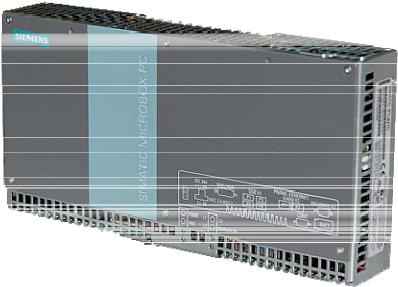
Description |
3 |
3.1Overview
The SIMATIC IPC427C provides high-level industrial performance.
●Compact design
●Maintenance-free operation
●High degree of ruggedness
Figure 3-1 SIMATIC IPC427C
SIMATIC IPC427C |
11 |
Operating Instructions, 04/2009, A5E02414743-01 |

Description
3.2 Applications
3.2Applications
The device provides industrial PC systems for high-performance and space-saving applications in particular in the field of machine, systems and switchgear cabinet engineering:
●Measuring and controlling of process and machine data (for example, automated washing systems, assembling machines, packaging machines)
●Operating and visualization tasks with separate display / monitor solutions (information terminals, large-scale displays in automotive production)
●Data logging and processing (for example, system data logging, distributed process control)
12 |
SIMATIC IPC427C |
Operating Instructions, 04/2009, A5E02414743-01 |

Description
3.3 Features
3.3Features
Basic data |
|
|
Installation / mounting |
• Installation on a DIN rail |
|
|
• |
Wall mounting |
|
• |
Vertical mountin |
|
• |
Hanging assembly |
|
|
|
Processor |
• Intel Celeron M 1.2 GHz, 800 MHz FSB, 1 MB SLC or |
|
|
• Intel Pentium Core 2 Solo 1.2 GHz, 800 MHz FSB, |
|
|
|
3 MB SLC or |
|
• Intel Pentium Core 2 Duo 1.2 GHz, 800 MHz FSB, |
|
|
|
3 MB SLC |
|
|
|
Main memory |
• 512 MB DDR3-SDRAM SODIMM |
|
|
• 1 GB DDR3-SDRAM SODIMM |
|
|
• 2 GB DDR3-SDRAM SODIMM |
|
|
• 4 GB DDR3-SDRAM SODIMM |
|
|
|
|
Free slots for expansion |
Up to 3 x PCI/104 modules or 3x PC/104-Plus module |
|
|
(PCI bus only); |
|
|
installed with expansion frame |
|
Graphics |
• Integrated Intel GMA4500 graphics |
|
|
• CRT resolution of 640x480 pixels up to 1920x1200 |
|
|
|
pixels |
|
• DVI resolution of 640x480 pixels up to 1920x1200 |
|
|
|
pixels |
|
• 8-512 MB graphics memory taken from main memory |
|
|
|
(dynamic UMA) |
|
|
|
Power supply |
24 VDC (19.2 – 28.8 V) max. 4 A |
|
Conditions of use |
• |
Operation without fan |
|
|
|
Drives and storage media |
|
|
Compact Flash card |
• 256 MByte optional or |
|
|
• 2 GB optional or |
|
|
• 4 GB optional or |
|
|
• |
8 GB optional |
|
|
|
Hard disk |
≥ 80 GB SATA HD 2.5" optional |
|
SSD (Solid State Disk) |
≥ 32 GB optional |
|
Floppy/CDROM drive |
Connected via external USB port |
|
USB stick |
Connected via external USB port |
|
SIMATIC IPC427C |
13 |
Operating Instructions, 04/2009, A5E02414743-01 |

Description
3.3 Features
Basic data
Ports
Serial |
COM1 (RS232) |
|
|
COM2 (RS232); optional |
|
Graphics |
DVI-I: combined DVI and VGA |
|
USB |
4 x USB 2.0 high current |
|
Ethernet |
2 x RJ 45 (10/100/1000 Mbps) |
|
PROFIBUS DP |
12 Mbps (isolated potential, |
|
|
compatible to CP 5611), optional |
|
CAN interface |
Optional |
|
Keyboard, mouse |
Connected via external USB port |
|
|
|
|
Monitoring and safety functions |
|
|
Temperature |
• When permitted temperature range is exceeded |
|
|
• Warnings can be analyzed by application program |
|
|
|
(local, via LAN) |
|
|
|
Watchdog |
• Monitoring function for program execution |
|
|
• Restart can be parameterized in the event of a fault |
|
|
• Warnings can be analyzed by application program |
|
|
|
(local, via LAN) |
|
|
|
LED display |
4 LEDs for displaying system status |
|
|
2 of these can be programmed by the user1 |
|
Transient voltage interruption |
Up to 15 ms buffer time at full load |
|
Buffer memory |
2 MB battery-buffered SRAM1 |
|
|
|
|
Software |
|
|
Operating systems |
|
|
Available |
• |
Without |
|
• Windows Embedded Standard 2009 |
|
|
• Windows XP Professional MUI SP3 preinstalled 2 |
|
Project-specific |
• |
LINUX |
|
• |
QNX |
|
• |
VxWorks |
|
• |
Others on request |
|
• RMOS3 V3.40 (ordered separately) |
|
|
|
|
1You can find additional information about addressing the LEDs or the SRAM under a Windows operating system in the section "Output register LED L1/L2". You can find example programs for addressing the LEDs under Windows XP and under RMOS3 under the FAQ at the Customer Support site Industry Automation and Drive Technologies - Homepage (http://www.siemens.com/automation/service&support).
2 MUI: Multi Language User Interface; 5 languages (English, German, French, Spanish, Italian)
14 |
SIMATIC IPC427C |
Operating Instructions, 04/2009, A5E02414743-01 |

Description
3.4 Windows Embedded Standard 2009
3.4Windows Embedded Standard 2009
The supplied Windows Embedded Standard has the product version 2009. The overview shows the basic device functions under Windows Embedded Standard 2009:
|
Function |
Hard disk / SSD version |
Compact Flash card version |
|
Enhanced Write Filter (EWF) |
In RAM RAM(REG) |
In RAM RAM(REG) |
|
SIMATIC IPC DiagBase |
Available V 1.2 |
Available V 1.2 |
|
Pagefile |
Deactivated in favor of the |
Deactivated in favor of the EWF |
|
|
EWF |
|
|
System Restore Core |
Available |
Available |
|
File based Writefilter (FBWF) |
Available |
Available |
|
Registryfilter |
Available |
Available |
|
Device Update Agent (DUA) |
Available |
Available |
|
HORM |
Available |
Available |
|
Telnet Server |
Available |
Available |
|
Windows Backup |
Available |
Available |
|
User Mode Driver Framework |
Available |
Available |
|
(UMDF) |
|
|
|
MUI |
GER/FRA/ITA/SPA |
GER |
|
|
Default language: English |
default language: English |
|
Administrator Account |
Available |
Available |
|
User Account |
Available |
Available |
|
Explorer Shell |
Available |
Available |
|
Internet Explorer (IE) |
Available, IE7 |
Available, IE7 |
|
Internet Information Server (IIS) |
Available V 5.1 |
Available V 5.1 |
|
Terminal Services |
Available |
Available |
|
Bluetooth |
Available |
Available |
|
Wireless Network Support |
Available |
Available |
|
Windows Firewall |
Available |
Available |
|
Windows Security Center |
Available |
Available |
|
MSN Explorer |
Available |
Not available |
|
Outlook Express |
Available |
Available |
|
Administrative Tools |
Available |
Available |
|
SMS Advanced Client |
Available |
Not available |
|
Remote Desktop |
Available V 6.0 |
Available V 6.0 |
|
Remote Assistance |
Available |
Available |
|
.NET Framework |
Available, V3.5 |
Not available |
|
ASP.NET |
Available, V3.5 |
Not available |
|
Windows .NET Messenger |
Available V 4.7 |
Available V 4.7 |
|
Code pages/User |
Available |
Selection available |
|
Location/Keyboard |
|
|
|
Disk Management Services |
Available |
Available |
|
Windows Installer Service |
Available V 3.1 |
Available V 3.1 |
|
Class Installer |
Available |
Available |
SIMATIC IPC427C |
|
15 |
|
Operating Instructions, 04/2009, A5E02414743-01 |
|
||

Description
3.4 Windows Embedded Standard 2009
Function |
Hard disk / SSD version |
Compact Flash card version |
CoDevice Installer |
Available |
Available |
Windows Movie Maker |
Available V 2.1 |
Not available |
Media Player |
Available, V11.0 |
Available, V11.0 |
Windows Media Player Tour |
Available |
Not available |
DirectX |
V9.0c |
V9.0c |
Accessories |
Available |
Available |
Help files for all components |
Available |
Not available |
Games |
Available |
Not available |
Fonts |
316 |
118 |
Windows XP Tour |
Available |
Not available |
Microsoft Silverlight |
Available V 1.0 |
Available V 1.0 |
NetMeeting |
Available V 3.1 |
Available V 3.1 |
Note
Activation of "HORM" and creation of a "Hiber File"
When "HORM" is activated, the "Hibernate" function can be used for Windows Embedded Standard 2009:
• EWFMGR C: /activatehorm
"Hibernate" is activated following a restart. The system then always boots from this file.
16 |
SIMATIC IPC427C |
Operating Instructions, 04/2009, A5E02414743-01 |
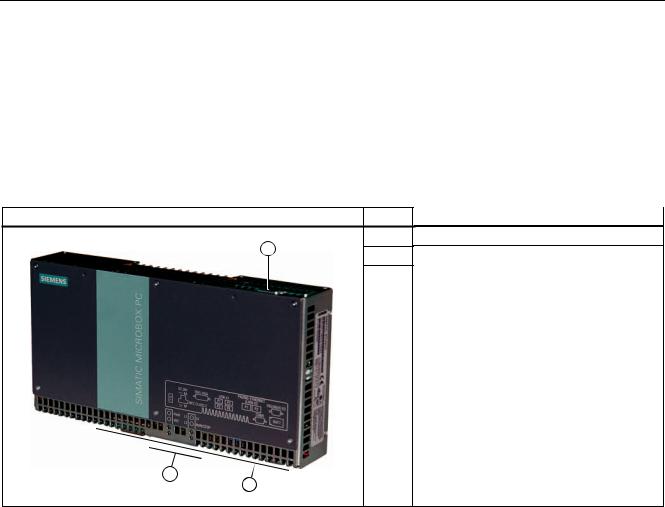
Description
3.5 Design
3.5Design
3.5.1External Design
Device components |
Pos |
Description |
Cover plate for Compact Flash module
Connection elementsStatus displays
SIMATIC IPC427C |
17 |
Operating Instructions, 04/2009, A5E02414743-01 |
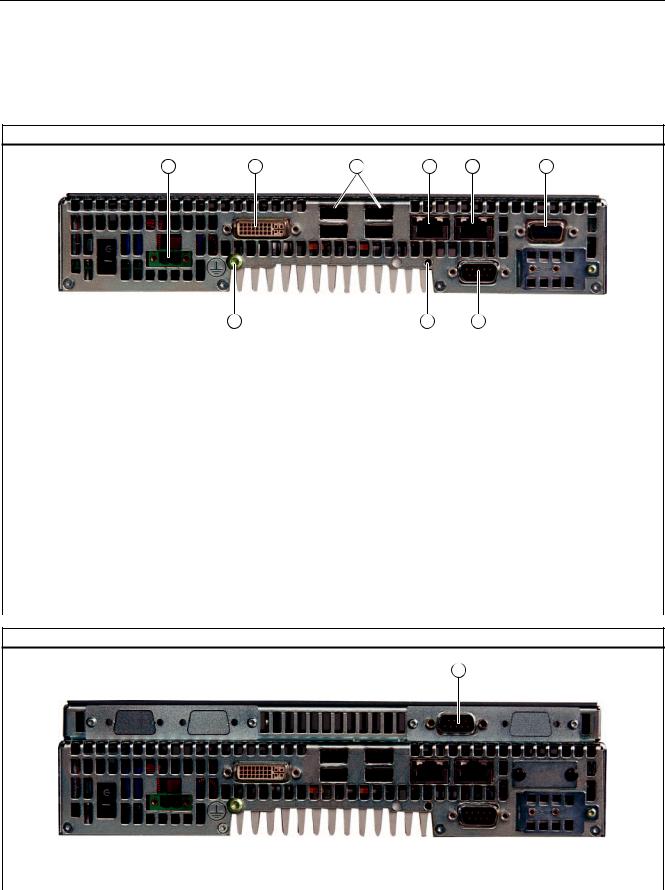
Description
3.5 Design
3.5.2Connection components
Ports and power supply
Location of connection elements (version with PROFIBUS or CAN)
|
|
|
|
|
|
|
|
|
|
|
|
|
|
|
|
Pos |
Name |
Description |
|
|
|
24 VDC |
Connection for a 24 V DC power supply |
|
|
|
DVI/VGA |
DVI/VGA connection for CRT or LCD monitor with DVI interface |
||
|
USB |
4 USB 2.0 connections, high-speed / low current |
|
|
|
PN/IND. ETHERNET |
RJ45 Ethernet connection 1 (exclusive PCI interrupt) for 10/100/1000 Mbps |
||
|
PN/IND. ETHERNET |
RJ45 Ethernet connection 2 (shared PCI interrupt) for 10/100/1000 Mbps |
||
|
PROFIBUS DP/MPI |
PROFIBUS DP/MPI interface (RS 485 isolated), 9-pin Cannon socket or CAN fieldbus |
||
|
CAN fieldbus |
(on request) |
|
|
|
|
|
|
|
|
COM1 |
Serial port (RS232) 9-pin Cannon connector |
|
|
|
USB strain-relief |
The USB strain relief must be fastened to the device enclosure with an oval-head screw |
||
|
fastener |
(M4 thread). The USB cables can be fastened to the strain-relief assembly with a cable |
||
|
|
tie. |
|
|
|
PE terminal |
The PE terminal (M4 thread) must be connected to the protective ground conductor of the |
||
|
|
plant, in which the device is to be installed. The minimum conductor cross-section may not |
||
|
|
be less than 2,5 mm2. |
|
|
Location of the connection elements (second COM interface)
Pos |
Designation |
Description |
|
COM2 |
Serial port (RS232) 9-pin Cannon connector |
18 |
|
SIMATIC IPC427C |
|
Operating Instructions, 04/2009, A5E02414743-01 |
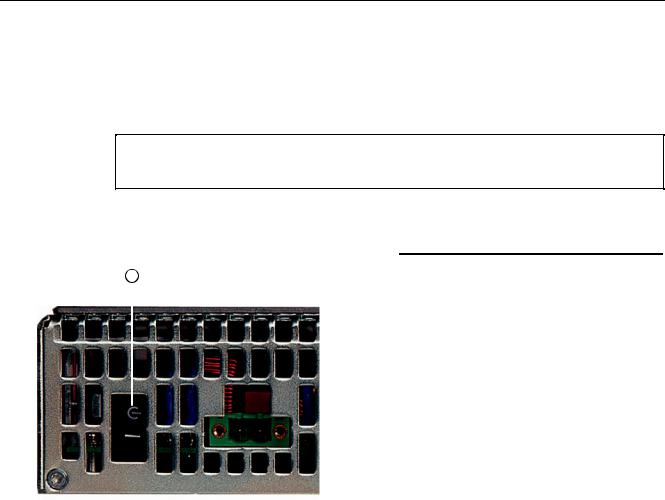
Description
3.5 Design
3.5.3Operator controls
On/Off switch
 CAUTION
CAUTION
The On/Off switch does not disconnect the device from the supply voltage.
Position of on/off switch |
Pos |
Description |
|
|
The on/off switch turns off the output voltages of |
|
|
the power supply but not disconnect from the |
|
|
|
|
|
supply system. |
|
|
The delivery condition is: Power switch turned |
|
|
off. |
|
|
|
SIMATIC IPC427C |
19 |
Operating Instructions, 04/2009, A5E02414743-01 |
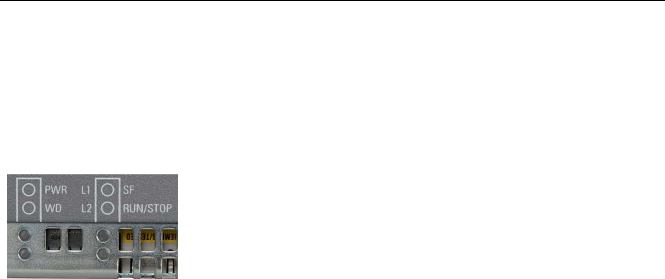
Description
3.5 Design
3.5.4Status displays
Status displays |
LED |
Meaning |
LED |
Description |
|
PWR |
Power supply |
OFF |
Standby mode |
|
|
|
GREEN |
Supply voltage available |
|
WD |
Watchdog status display |
OFF |
Watchdog disabled Watchdog |
|
|
|
GREEN |
enabled, monitoring time not |
|
|
|
|
expired |
|
|
|
|
Watchdog enabled, monitoring |
|
|
|
RED |
time expired |
|
L1 |
User LED L1 |
OFF |
Can be controlled by user |
|
|
|
YELLOW |
programs1 |
|
SF |
|
RED |
|
|
|
Group errors |
RED |
Can be controlled by controller |
|
|
|
|
program (e.g. WinAC)1 |
|
L2 |
User LED L2 |
OFF |
Can be controlled by user |
|
|
|
YELLOW |
programs1 |
|
RUN/STOP |
|
GREEN |
|
|
|
RUN |
GREEN |
Can be controlled by controller |
|
|
STOP |
YELLOW |
program (e.g. WinAC)1 |
|
|
|
|
|
1You can find additional information about addressing the LEDs or the SRAM under a Windows operating system in the section "Output register LED L1/L2". Example programs for addressing the LEDs under Windows XP and under RMOS are available under the FAQ at the Customer Support site Industry Automation and Drive Technologies - Homepage (http://www.siemens.com/automation/service&support).
20 |
SIMATIC IPC427C |
Operating Instructions, 04/2009, A5E02414743-01 |

Application planning |
4 |
4.1Transport
Despite the device's rugged design, its internal components are sensitive to severe vibrations or shock. You must therefore protect the device from severe mechanical stress when transporting it.
You should always use the original packaging for shipping and transporting the device.
CAUTION
Risk of damage to the device!
If you are transporting the device in extreme weather conditions with large fluctuations in temperature, care must be take to ensure that no moisture forms on or in the device (condensation).
If condensation has developed on the device, wait at least 12 hours before you switch it on.
SIMATIC IPC427C |
21 |
Operating Instructions, 04/2009, A5E02414743-01 |
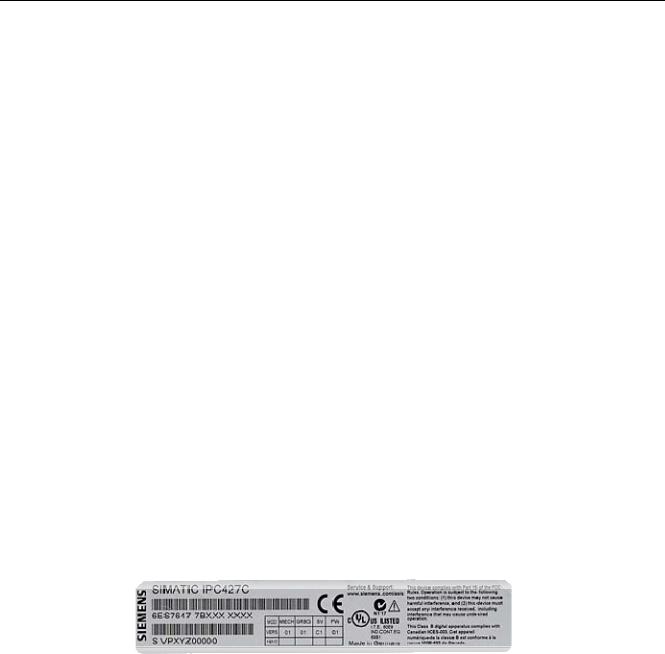
Application planning
4.2 Unpacking and checking the delivery unit
4.2Unpacking and checking the delivery unit
Unpacking the device
Note the following when unpacking the unit:
●It is advisable not to dispose of the original packing material. Keep it in case you have to transport the unit again.
●Please keep the documentation in a safe place. It is required for initial commissioning and is part of the device.
●Check the delivery unit for any visible transport damage.
●Verify that the shipment contains the complete unit and your separately ordered accessories. Please inform your local dealer of any disagreements or transport damages.
Noting the device identification data
The device can be identified uniquely with the help of these numbers in case of repairs or theft.
Enter the data in the following table:
Serial number |
...S VP |
Order number of the device |
6ES 7647-7B ... |
Microsoft Windows Product Key |
|
Ethernet address 1 |
|
Ethernet address 2 |
|
You can find the corresponding data here:
●Serial number: The serial number is available on the rating plate on the right side of the device.
●Order number of the device: The order number is located on the rating plate.
22 |
SIMATIC IPC427C |
Operating Instructions, 04/2009, A5E02414743-01 |
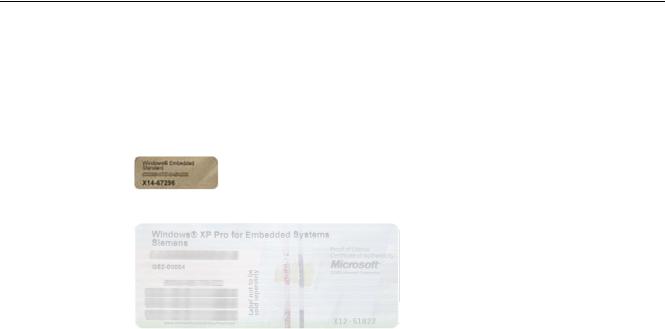
Application planning 4.2 Unpacking and checking the delivery unit
●Ethernet address: The Ethernet address of the device is available in your BIOS Setup (F2 function key) under Main > Hardware Options > Ethernet 1 Address or
Ethernet 2 Address.
●Microsoft Windows "Product Key" from the "Certificate of Authenticity" (COA): The COA label is only present in pre-installed Windows Embedded Standard 2009 or
XP Professional and is affixed to the back of the device.
Figure 4-1 COA Label Windows Embedded Standard 2009
Figure 4-2 COA Label Windows XP Pro for Embedded Systems
SIMATIC IPC427C |
23 |
Operating Instructions, 04/2009, A5E02414743-01 |

Application planning
4.3 Ambient and Environmental Conditions
4.3Ambient and Environmental Conditions
When you plan your project, you should make allowances for:
●The climatic and mechanical environmental conditions specified in the specifications given in your operating instructions.
●The device is approved for operation in closed rooms only.
●Avoid extreme ambient conditions. Protect the device against dust, moisture and heat.
●Do not place the device in direct sunlight.
●Ensure that the distance to other components or the sides of cabinets is at least 50 mm above and 100 mm below the device.
●Do not cover the ventilation slots of the device.
●Always observe the mounting positions permitted for this device.
●The connected or built-in peripherals should not introduce a counter emf in excess of 0.5 V into the device.
24 |
SIMATIC IPC427C |
Operating Instructions, 04/2009, A5E02414743-01 |
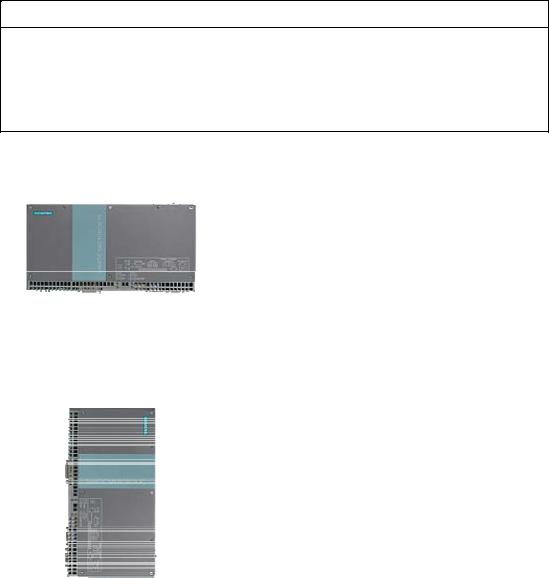
Installing/mounting |
5 |
5.1Permitted mounting positions
NOTICE
The device is approved for operation in closed rooms only.
Ensure that there is a minimum clearance to the other components or the walls of a housing:
•Below at least 100 mm
•Above at least 50 mm
Horizontal (preferred position) |
Permitted temperatures |
|
Operation with hard disk: |
|
• with up to 3 expansion modules |
|
(max. load 9 W): +5 to +40°C |
|
Operation with CompactFlash card and/or SSD drive: |
|
• with up to 3 expansion modules |
|
(max. load 9 W): 0 to +45°C |
|
• with up to 3 expansion modules |
|
(max. load 9 W) in RAL: 0 to +50°C |
|
Operation with Compact Flash cards: |
|
• without expansion modules in RAL: 0 to +55°C |
|
|
Vertical |
|
(power supply at the top) |
|
|
Operation with hard disk: |
|
• with up to 3 expansion modules |
|
(max. load 9 W): +5 to +40°C |
|
With installed Compact Flash card: |
|
• without expansion modules: 0 to +45°C |
|
Operation with CompactFlash card and/or SSD drive: |
|
• with up to 3 expansion modules |
|
(max. load 9 W) in RAL: 0 to +45°C |
|
Operation with Compact Flash cards: |
|
• with up to 3 expansion modules |
|
(max. load 9 W) in RAL: 0 to +50°C |
|
Notes: |
|
When mounted on a DIN rail, the device should be secured |
|
to prevent shifting (e.g. with a DIN rail ground terminal). |
SIMATIC IPC427C |
25 |
Operating Instructions, 04/2009, A5E02414743-01 |
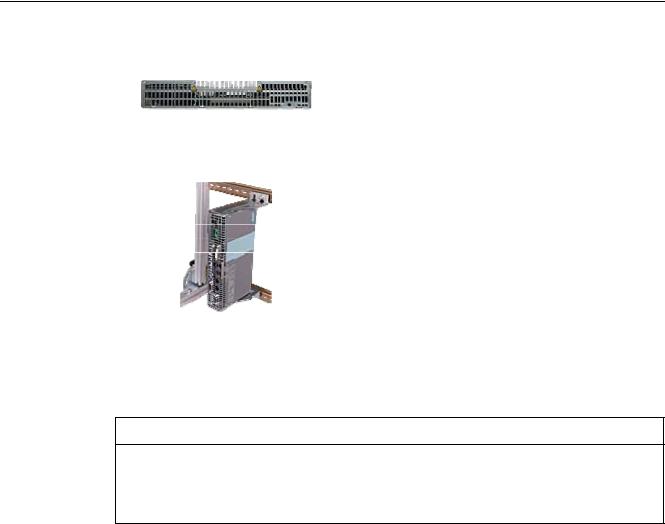
Installing/mounting
5.1 Permitted mounting positions
|
|
Suspended |
|
|
Operation with CompactFlash card and/or SSD drive and |
|
without expansion modules: |
|
0 to +40°C |
|
Note: |
|
Mounting brackets are required if the device is suspended. |
Upright mounting |
Permitted temperatures |
|
Operation with hard disk: |
|
• with up to 3 expansion modules |
|
(max. load 9 W): +5 to +40°C |
|
With installed Compact Flash card: |
|
• without expansion modules: 0 to +45°C |
|
Operation with CompactFlash card and/or SSD drive: |
|
• with up to 3 expansion modules |
|
(max. load 9 W) in RAL: 0 to +45°C |
|
Operation with Compact Flash cards: |
|
• with up to 3 expansion modules |
|
(max. load 9 W) in RAL: 0 to +50°C |
|
|
RAL = Restricted Access Location
(e.g. installation of the unit in a lockable cabinet)
NOTICE
The safety and installation instructions for the expansion modules should be followed if the device is expanded with PCI-104 / PC/104-plus modules.
If necessary, the device should be installed in an enclosure that meets the requirements of paragraphs 4.6 and 4.7.3 of IEC/UL/EN/DINEN60950-1.
26 |
SIMATIC IPC427C |
Operating Instructions, 04/2009, A5E02414743-01 |

Installing/mounting 5.2 Mounting information
5.2Mounting information
Before you install the device, read the following mounting instructions.
NOTICE
Adhere to the SIMATIC assembly guidelines and the relevant DIN/VDE requirements or the country-specific regulations when mounting in switching cabinets.
NOTICE
Ensure that the device is classified as "Open Type" when using the device in the area of Industrial Control Equipment (UL508). A UL508 conform enclosure is therefore a mandatory requirement for approval or operation according to UL508.
5.3Mounting the device
Mounting methods
SIMATIC IPC427C can be mounted on DIN rails, with mounting brackets and in an upright position.
SIMATIC IPC427C |
27 |
Operating Instructions, 04/2009, A5E02414743-01 |

Installing/mounting
5.4 Mounting on DIN rails
5.4Mounting on DIN rails
Mounting the device on DIN rails
Note
Use of Siemens 35 mm standard mounting rail is recommended.
Steps for mounting on DIN rails
1.Set the device inclined on the upper DIN rail.
2.Swing the device fully onto the rails until both clamps completely latch.
Note
To ensure secure mounting on vertical mounting rails, a DIN rail ground terminal should be mounted beneath the device.
28 |
SIMATIC IPC427C |
Operating Instructions, 04/2009, A5E02414743-01 |

Installing/mounting 5.4 Mounting on DIN rails
NOTICE
The rails are secured to a wall or cabinet similar to mounting with mounting brackets. Ensure that the wall or ceiling can hold four times the total weight of the device (including the rails and additional expansion modules). Also see section Mounting with mounting brackets (Page 30).
Removing the device from the DIN rail
●Push down the device until the clamps release it.
●Swing the device out of the rails.
SIMATIC IPC427C |
29 |
Operating Instructions, 04/2009, A5E02414743-01 |

Installing/mounting
5.5 Mounting with mounting brackets
5.5Mounting with mounting brackets
Removing mounting clamps from the device
Two mounting clamps are factory installed on the device for DIN rail mounting. These need to be removed before mounting the mounting brackets.
Steps for removing the mounting clamps
Remove the four screws and the two mounting clamps from the back of the device.
Installing brackets on the device
Two mounting brackets are included in the device package. They can be installed on the device with four screws supplied.
Steps for installing the mounting brackets
Install the mounting brackets on the device.
Note Required tools
You need a TORX T20 screwdriver to remove the mounting clamps and mount the mounting brackets.
30 |
SIMATIC IPC427C |
Operating Instructions, 04/2009, A5E02414743-01 |
